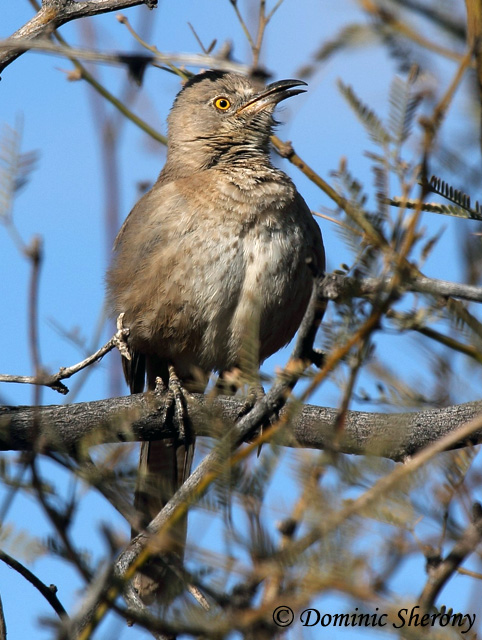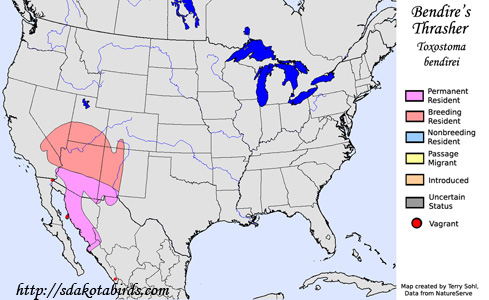Bendire's Thrasher
Toxostoma bendirei
| Length: 9.5 inches | Wingspan: 13 inches | Seasonality: Non-resident in South Dakota |
| ID Keys: Sandy-color overall, lighter below with small triangular spots on chest, bill shorter and straighter than other thrashers of arid West. | ||
 The
Bendire's Thrasher is another of the sandy-colored Thrasher species of the
arid Southwest. They are very similar in appearance to the
Curve-billed Thrasher and share
parts of that species' range, but the Bendire's Thrasher is distinguished
from many of the other arid West thrasher by their shorter and relatively
straight bill. Populations of Bendire's Thrashers have declined
significantly in recent decades, leading the IUCN to list them as a
"vulnerable" species. Habitat loss is the likely cause of the species'
decline.
The
Bendire's Thrasher is another of the sandy-colored Thrasher species of the
arid Southwest. They are very similar in appearance to the
Curve-billed Thrasher and share
parts of that species' range, but the Bendire's Thrasher is distinguished
from many of the other arid West thrasher by their shorter and relatively
straight bill. Populations of Bendire's Thrashers have declined
significantly in recent decades, leading the IUCN to list them as a
"vulnerable" species. Habitat loss is the likely cause of the species'
decline.
Habitat: Found in a variety of arid, semi-open habitats, including Sonoran desert habitat with scattered cacti and shrubs, and in shrubby areas with scattered understory of grasses.
Diet: Feeds heavily on insects and spiders. Will also sometimes feed on seeds, berries, and fruits, including fruits of cacti.
Behavior: Mostly forages by moving along the ground, picking up insects from the ground or gleaning them from vegetation. They will also sometimes use their bill to turn over rocks and make shallow scrapes in the ground.
Nesting: The nest of a Bendire's Thrasher is a cup built of twigs, lined with grasses, small roots, and other finer vegetative material. The nest is placed in a dense thicket or cactus, usually relatively close to the ground. The female usually lays 3 eggs, and both parents help to incubate them. When the eggs hatch, both parents help to feed and tend to the young. The young leave the nest after about 2 weeks. Bendire's Thrashers often will raise more than one brood per year.
Interactive eBird Map: Click to access an interactive eBird map of Bendire's Thrasher sightings
Song: The song is a rapid, jumbled series of throaty warbles.
Migration: Considered a permanent resident in the southern part of their range, particularly in Mexico. Those in the northern part of their U.S. range are migratory, moving southward a relatively short distance for the winter. Some birds in far southern U.S. portion of their range may be permanent residents, but numbers of birds decline in the middle of winter in this area.
Feeders: Will occasionally visit feeders for various seeds and fruits.
Similar Species: In range, most likely to be confused with the Curve-billed Thrasher, but the bill is shorter and straighter than that species.
Conservation Status: Habitat loss and fragmentation in some areas has led to significant declines in number. The IUCN currently lists the Bendire's Thrasher as a "Vulnerable" species.
Further Information: 1) Audubon Guide - Bendire's Thrasher
2) BirdLife International - Bendire's Thrasher
3) New Mexico Partners In Flight - Bendire's Thrasher
Photo Information: Photo taken by Dominic Sherony - Photo licensed under Creative Commons Attribution ShareAlike 2.0 Generic License.
| Click below for a higher-resolution map |
 |
| South Dakota Status: Non-resident in South Dakota |
Additional Bendire's Thrasher Photos (coming soon!!)
